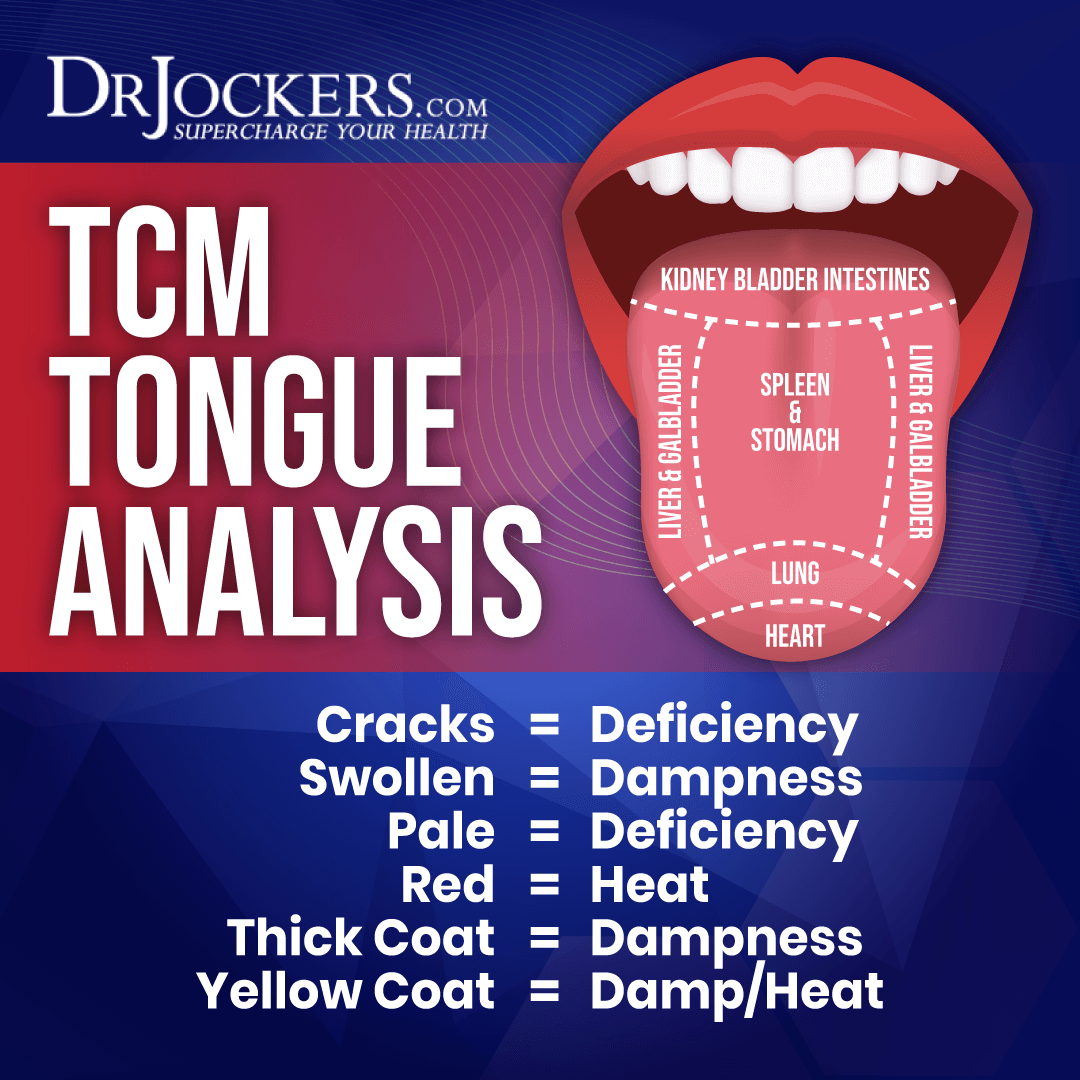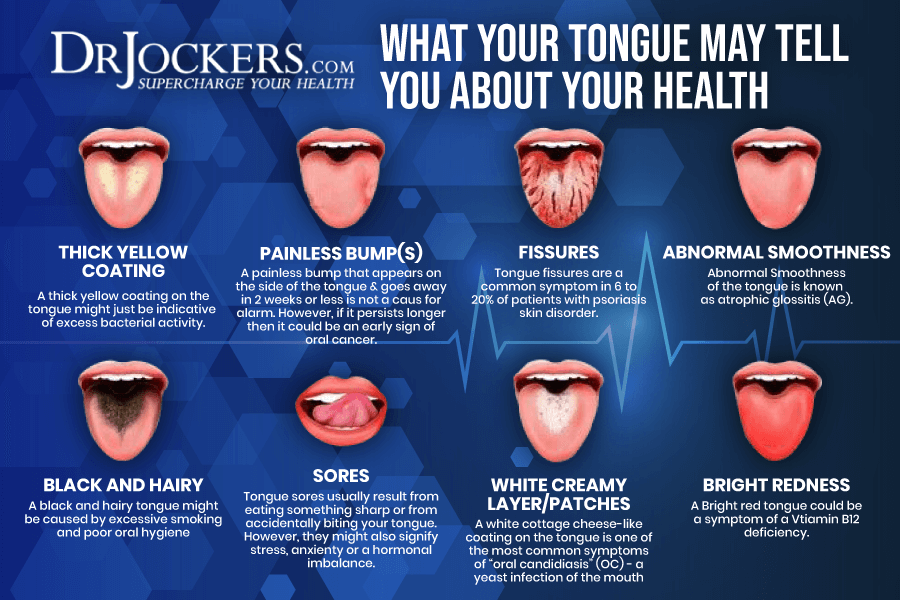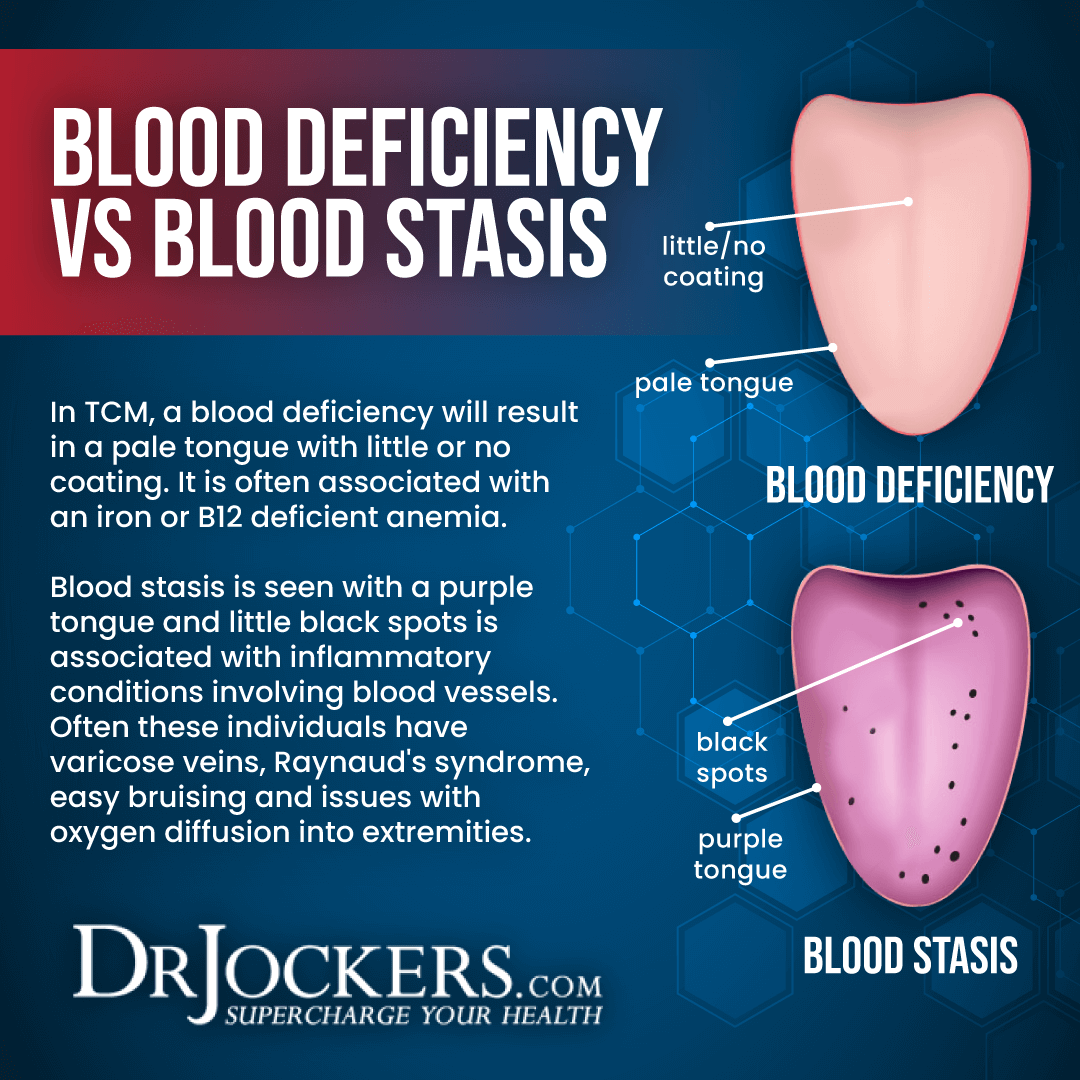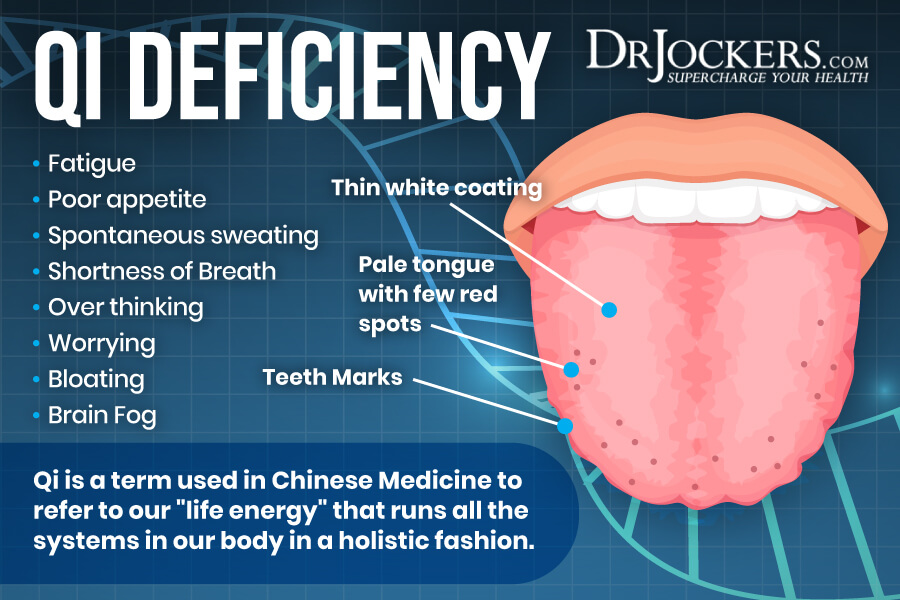 Tongue Mapping To Discover Hidden Health Problems
Tongue Mapping To Discover Hidden Health Problems
Have you ever been to a doctor and been asked to stick your tongue out? I bet not. Examining your tongue is not part of modern medicine. Tongue diagnosis or tongue mapping, however, is an essential part of the assessment, evaluation, and diagnosis in Traditional Chinese Medicine (TCM).
In this article, you will learn about tongue mapping. You will learn what tongue mapping is. You will learn about key tongue characteristics TCM practitioners look for. I will go over typical tongue patterns and what they mean for your health.

What is Tongue Mapping
Tongue mapping or tongue diagnosis is an important part of Traditional Chinese Medicine (TCM). Practitioners of TCM and acupuncturists regularly use tongue mapping as a tool for assessment, evaluation, and diagnosis. But why?
TCM believes that your tongue is a road map of your health. They believe that your tongue mirrors what’s going on in your body and your health. By observing your tongue, they can get important information about your blood circulation, hydration levels, energy levels, digestion, respiratory function, heart health, liver and kidney health, and more.
According to TCM, each part of your tongue represents one of the Acupuncture meridians. Meridians may sound a bit woo-woo in the Western world. However, TCM has been around for over 3,500 years. In comparison, Western medicine we rely on today has only been around since the 19th century. Western or modern medicine certainly offers a lot of important life-saving strategies and opportunities for research advancements. However, we should not forget about Eastern strategies that draw wisdom from our bodies. we can draw a lot of wisdom from an ancient medical system that is still used and relevant today.
TCM describes the meridians as your energetic pathways that are basically the energetic highway in the human body. Your meridians are pathways that allow the flow of energy known as Qi (pronounced: “chee”). Through your meridians, Qi can circulate throughout your body.
Your meridians exist in pairs. Each meridian has several acupuncture points that can be used during acupuncture and reflexology sessions to allow a healthy flow of energy and recreate balance and health.
As said, your tongue also corresponds to these meridians. The top of your tongue corresponds with your heart. The next section represents the liver. The middle of your tongue is a representation of your stomach and spleen, while the back corresponds with your intestines, kidneys, and bladder. The sides indicate information about your liver and gallbladder health.

Key Tongue Characteristics
When your acupuncturist, TCM practitioner, or other holistic practitioner asks you to stick out your tongue for tongue mapping, they are observing your tongue for the following characteristics:
- Shape: Is your tongue small, pointed, puffy, or enlarged?
- Color: Is your tongue pale, gray, red, or purple?
- Texture: Is your tongue wet, dry, greasy, or glossy?
- Coating or ‘fur: Is your tongue thin or thick? Is there any ‘fur’ distributed on the surface?
- Fur features: If there is ‘fur’ on your tongue, what is the color and texture?
- Body features or markings: Are there any spots, cracks, bumps, raised speckles, ulcers, or other deviations on your tongue?
These tongue mapping observations will help your practitioners to look at some tongue patterns and identify some underlying health issues to address. Tongue mapping doesn’t take long. Your practitioner will only look at your tongue for a few seconds, 2 or 3 times. They watch for the shape, color, texture, coating, markings, and other aspects. They will look at the tip of your tongue and under your tongue too.
The color of your tongue reflects the state of your Qi. A healthy tongue is light red or dark pink, indicating healthy blood, circulation, and organ health. A pale tongue may indicate blood deficiency or imbalance. Purple may indicate clotting or blood stagnation. Bright red refers to the presence of excess or deficiency in heat, causing disharmony in the body.
Your body shape may tell a lot about your Qi, Yin Ye (fluid), and Xue (blood) health. In a healthy body, your tongue should fit in your mouth easily without pushing against the teeth causing markings and dents in the edges. Tooth markings or a puffy or swollen tongue may indicate digestive imbalance. A thin tongue may be due to fluid or blood deficiencies. A quivering tongue may indicate digestive or liver imbalances.
Coating and markings may also indicate imbalances. A healthy tongue only has a very thin white coating. A thick coating may be due to having or about to be getting a cold or digestive imbalance. White coating on the surface, greasy or sticky coaching may be an indication of so-called Phlegm or Damp energy patterns, whereas thick and yellow coating may indicate Damp-Heat energy patterns your acupuncturist can address. Cracks may be a sign of an internal heat imbalance. Red dots on your tongue may indicate Yin deficiency and Empty Heat energy patterns.

Tongue Patterns
If all these TCM terms feel confusing to you, I’m here to break them down. These are the tongue patterns your practitioner may be looking for, and here is what they mean.
Healthy Tongue
A healthy or normal-looking tongue is fresh pink or light red in color. The thickness is medium. There is a thin, rooted light coating that you can scrape off easily. There are no teeth marks, spots, cracks, ulcers, or other markings.
Blood Deficiency
Having a pale tongue with little to no coating may mean that you have blood deficiency. There may also be some teeth marks on your tongue.
Blood deficiency is generally characterized by fatigue, dry or thinning hair, dizziness, heart palpitations, ridged and brittle nails, poor memory, poor concentration, anemia, insomnia, light or absent menstrual periods in females, and gynecological issues in females. It is often commonly associated with an iron or B12 deficient form of anemia.

Blood Stasis
Having a purple or mauve tongue with red or black spots may mean blood stasis. This is often associated with inflammation in the blood vessels. The veins underneath your tongue may also be dark, distended, or enlarged.
If you have blood stasis, you may be experiencing leg pain, cold limbs, varicose veins, Raynaud’s syndrome, bruising, poor skin, liver spots, skin dryness, scaling, chest pain, stabbing or sharp pain, and headaches.
Heat
A red tongue with a thin and yellow coating and possible red spots may indicate heat. Heat is common in people that ‘run hot’, feel thirsty often, sweat easily, are constipated, have acne, are easily agitated, are short-tempered, and are irritable.
Qi Deficiency
If you have a pale tongue with white quoting, teeth marks, and maybe a few spots, you have Qi deficiency. Qi deficiency is common in people who have low energy, fatigue, gas, bloating, other digestion issues, poor appetite, shortness of breath with exertion, and who worry and overthink things a lot.

Qi Stagnation
If the tip of your tongue is red, you may have Qi stagnation. With Qi stagnation, we may also observe redness on the side of the tongue and a thin, white coating. Qi stagnation is often observed in people who have muscle tension, pain that gets worse with emotional stress, poor sleep, mood swings, depression, irritability, a tendency to get stressed or emotionally upset easily, digestion issues, and premenstrual symptoms in females.
Yin Deficiency
Having a red to crimson tongue with no coating or only thin, little coating and some cracks may be a sign of Yin deficiency. Yin deficiency is common in people with insomnia, night sweats, hot flashes if in menopause, ringing in the ears, restlessness, joint pain, and muscle stiffness.
Yang Deficiency
If you have a pale, puffy, or enlarged tongue with some thick white coaching, you may have Yang deficiency. Yang deficiency generally occurs in people who feel cold easily, have chronic back or knee pain, have depression, feel emotionally apathetic, have low energy, feel exhausted or burnt out, have low libido or impotence in males, feel weak, have a tendency to panic, and have thyroid issues, especially hypothyroidism.

Damp Heat
A swollen, red tongue with a yellow and greasy coating is generally a sign of damp heat. Damp heat is common in people with chronic inflammatory issues, such as irritable bowel syndrome (IBS), inflammatory bowel disease (IBD), UTIs, acne, eczema, psoriasis, other skin issues, muscle pain that gets worse in hot or humid weather, and a tendency to get angry easily.
Damp Retention
Finally, a swollen or puffy tongue with a white, greasy, or oily coating may be a sign of damp retention. Damp retention or dampness is common in people who have problems with bloating, gas, loose stools, indigestion, nausea, candida, phlegm, lethargy, and muscle aches that get worse in wet, humid, or damp weather.

Inflammation Crushing Ebundle
The Inflammation Crushing Ebundle is designed to help you improve your brain, liver, immune system and discover the healing strategies, foods and recipes to burn fat, reduce inflammation and Thrive in Life!
As a doctor of natural medicine, I have spent the past 20 years studying the best healing strategies and worked with hundreds of coaching clients, helping them overcome chronic health conditions and optimize their overall health.
In our Inflammation Crushing Ebundle, I have put together my very best strategies to reduce inflammation and optimize your healing potential. Take a look at what you will get inside these valuable guides below!
Final Thoughts
Tongue mapping is an essential part of the assessment, evaluation, and diagnosis of TCM. It may give us additional information about your overall health and underlying imbalances. Natural variations in your tongue are normal, and noticing certain features doesn’t necessarily mean something pathological is happening. Certain variations may indicate imbalances, but you should avoid figuring it out on your own.
If you are noticing something while looking at your tongue, don’t panic. Accurate tongue mapping by an acupuncturist or TCM practitioner is critical for reading your tongue and recognizing issues correctly. Remember, these practitioners spend years studying this technique in school.
Certain foods and drinks can discolor your tongue, so it’s important to inform your practitioner if you’ve eaten or drank anything. Though scraping or brushing your tongue may be good for your oral health, it also changes the coating on your tongue. Inform your practitioner about your current dental routine for an accurate reading.
Tongue mapping is never used alone for diagnosis and your treatment plan. Acupuncturists and TCM practitioners may use pulse testing, a physical exam, questioning, or other strategies to determine the best plan. Additionally, you should not forget about blood, stool, urine, and other testing either to uncover the root causes of your symptoms.
If you want to work with a functional health coach, I recommend this article with tips on how to find a great coach. If you want further help with your health, we offer long-distance functional health coaching programs. For further support with your health goals, just reach out and our fantastic coaches are here to support your journey.




Please help white looking stick , hair , like stuff, back of tongue bumps, very dry mouth feels like I can’t swallow going to choke!!! Been the gut MD, MD, ENT, dentist no one can help or give me an answer!!